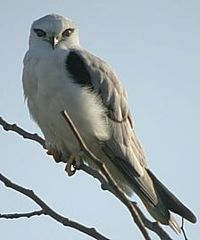


|
Falconiformes:
The order Falconiformes is a group of about 290 species of birds that include the diurnal birds of prey. Raptor classification is difficult and the order is treated in several ways. Problems in Classification:
Traditionally, all the raptors are grouped into 4 families in this single order. However, in Europe, it has become common to split the order into two: the falcons and caracaras remain in the order Falconiformes (about 60 species in 4 groups), and the remaining 220-odd species (including the Accipitridae — eagles, hawks, and many others) are put in the separate order Accipitriformes. A prehistoric family known only from fossils are the Horusornithidae. The idea that Falconiformes should be divided into many orders is because of the suggestion that the order may not share a single lineage that is exclusive of other birds. The most controversial but also most well-supported suggestion, is that Cathartidae are not Falconiformes but are related to the storks, in the separate order Ciconiiformes. However, morphological evidence supports the common ancestry of the Falconiformes, and the Strigiformes may be very close to the Falconiformes as well. The American Ornithologists' Union leaves Falconidae and Accipitridae in Falconiformes, but puts the New World vultures (family Cathartidae) with the storks in Ciconiiformes, following the influential Sibley-Ahlquist taxonomy, in which all the raptors are placed into Ciconiiformes, but the Cathartids are considered to be outside the lineage that includes other raptors. While the latter is apparently correct, the "Ciconiiformes" sensu Sibley & Ahlquist are a paraphyletic, artificial assemblage and one of the weakest point of their classification scheme.. Karyotype analysis indicates that New World vultures are indeed distinct, and the Accipitridae stand apart from all other falconiform birds insofar as that their microchromosomes show a high degree of merging to medium-sized chromosomes, which is quite unique in birds (de Boer 1975, Amaral & Jorge 2003, Federico et al. 2005). Whether this has any bearing on the validity of the proposed Accipitriformes is still a matter of dispute, but it at least proves that the accipitrids are a monophyletic group. Characteristics:
Falconiformes are known from the Middle Eocene (the possibly basal genus Masillaraptor from the Messel Pit) and typically have a sharply hooked beak with a cere (soft mass) on the proximodorsal surface, housing the nostrils. Their wings are long and fairly broad, suitable for soaring flight, with the outer 4–6 primaries emarginated. Falconiformes have strong legs and feet with raptorial claws and an opposable hind claw. Almost all Falconiformes are carnivorous, hunting by sight during the day or at twilight. They are exceptionally long-lived, and most have low reproductive rates. The young have a long, very fast-growing fledgling stage, followed by 3–8 weeks of nest care after first flight, and 1 to 3 years as sexually immature adults. The sexes have conspicuously different sizes, and monogamy is the general rule.
|
